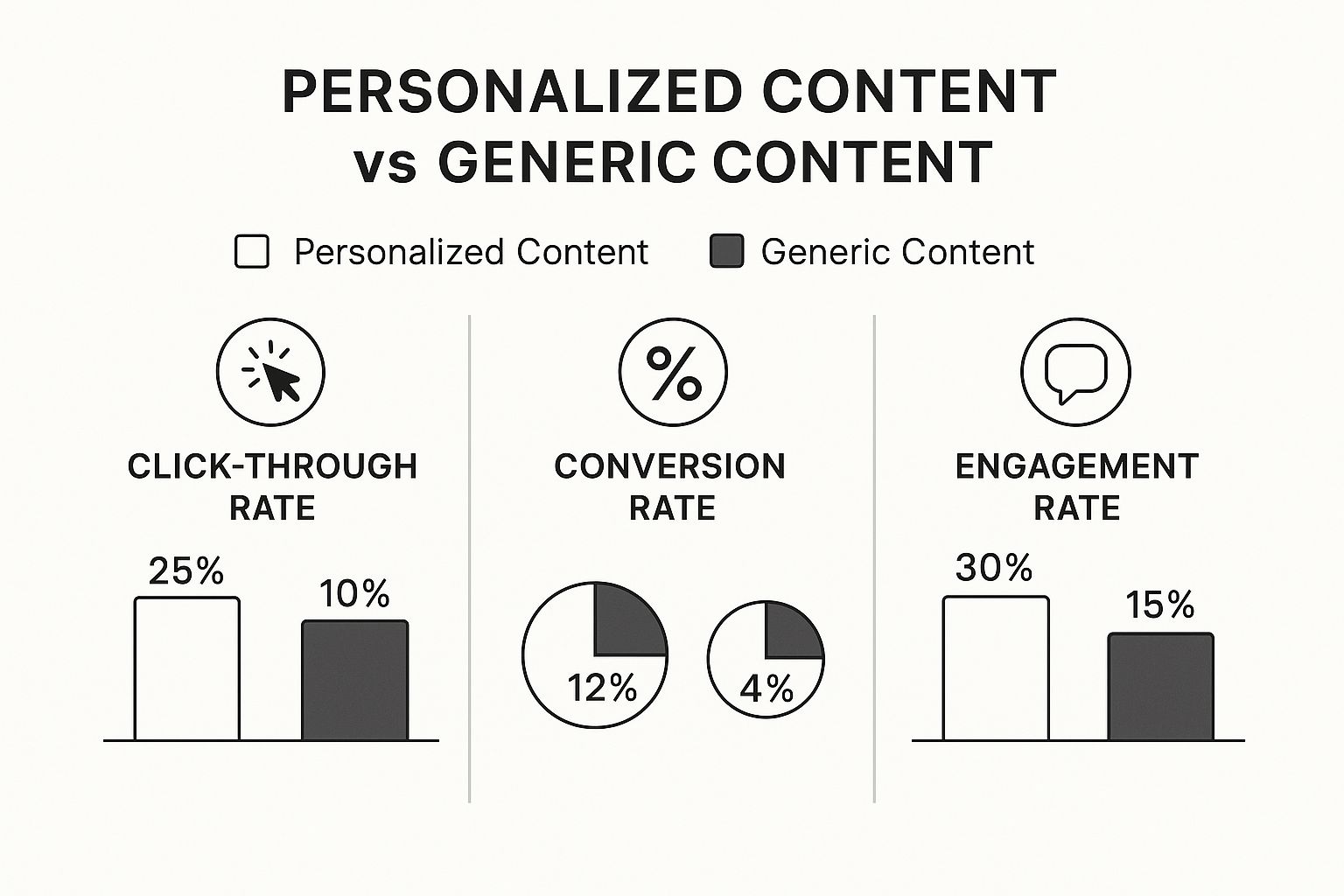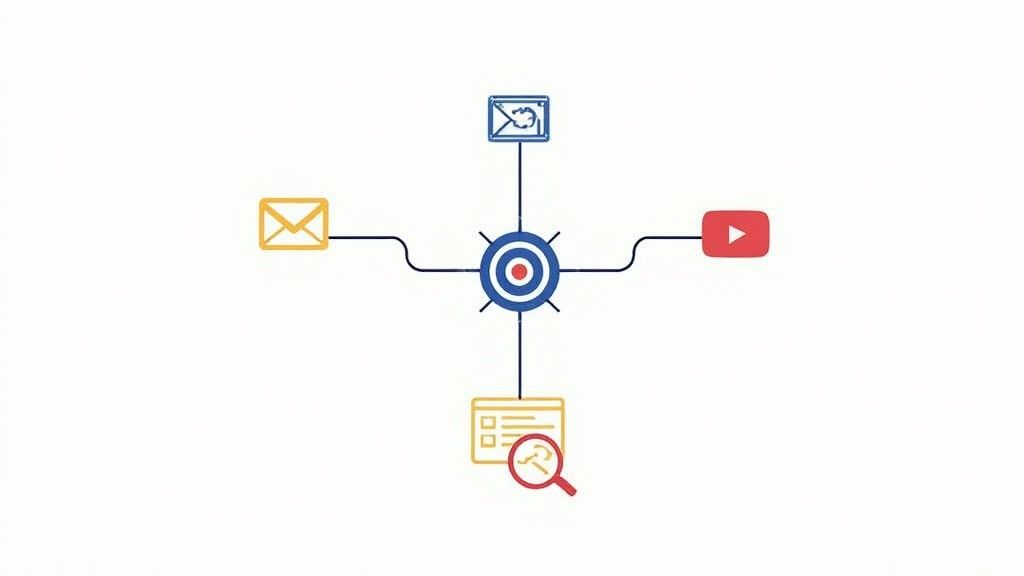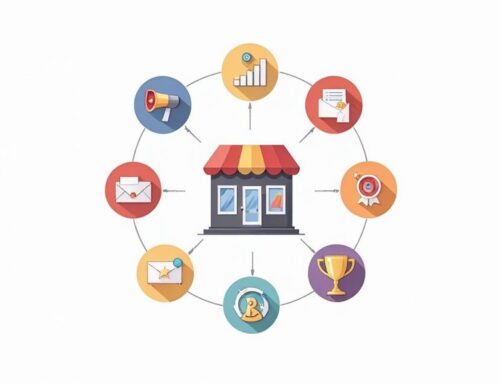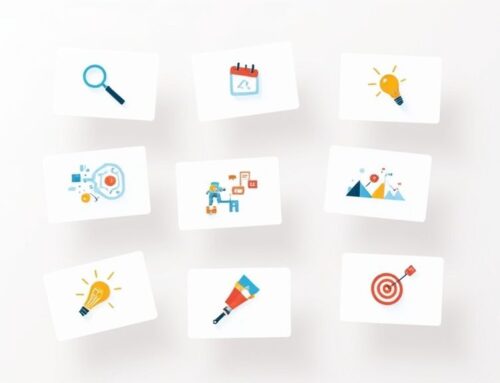Let’s be real for a moment: the “spray and pray” method of advertising is officially dead. If you’re not using a targeted approach to digital marketing, you’re not just falling behind; you’re risking becoming irrelevant. It’s the fundamental difference between shouting into an empty room and having a real conversation with someone who actually wants to hear what you have to say.
Why Generic Marketing No Longer Works
The old strategy of casting a massive net and just hoping you catch something is completely broken. People are absolutely flooded with thousands of ads every single day, and they’ve gotten incredibly good at filtering out anything that isn’t directly relevant to them. Your generic ad for a product they don’t need? It’s just more noise. Ignored and instantly forgotten.
This is where a precise, data-backed strategy completely changes the game. It allows you to stop guessing and start using real information to understand who your ideal customers are. And I don’t just mean basic demographics like age and location. I’m talking about getting to know their behaviors, their online habits, and what truly drives them to make a purchase.
The Shift to Precision
This isn’t just a theory; you can see it in how businesses are spending their money. By 2025, digital channels are expected to grab 72.7% of all advertising investment. In 2024 alone, spending is projected to blow past US$790 billion. That number has more than doubled since 2019, and the engine behind that growth is data. It’s what allows businesses to finally connect with the right people at the right time.
The big idea here is simple: Stop marketing to everyone. Start marketing to the right one. A targeted strategy respects your audience’s time and intelligence by offering them something valuable, not just another interruption.
From Annoyance to Added Value
Think about this classic example. A local gym blasts out a generic “Join Now!” email to its entire database. The message goes to happy current members, people who live an hour away, and everyone in between. What happens? Most of them hit delete without a second thought.
Now, picture that same gym getting smart about it.
- Segment 1: Current, active members get a “Bring a Friend for Free” offer.
- Segment 2: Past members who haven’t been back in six months receive a special “We Miss You” reactivation discount.
- Segment 3: A geo-targeted social media ad promotes a free trial to people within a three-mile radius who have shown an interest in fitness but aren’t members.
Suddenly, every single message is relevant, personal, and way more likely to get a positive reaction. This kind of focus is a game-changer for any company, but it’s an absolute lifeline when you’re crafting a plan for digital marketing for small business, where every single dollar has to work hard. You stop being just another advertiser and start becoming a helpful resource, which is how you build loyalty and see your campaign results skyrocket.
Building a Foundation with Smart Audience Segmentation

Any targeted approach to digital marketing that actually works starts with one thing: knowing exactly who you’re talking to. This isn’t just about splitting your audience by age or location. To really connect, you need to dig into the why behind their behavior. That’s where smart audience segmentation comes in.
Forget casting a wide, generic net and hoping for the best. The real magic happens when you create smaller, well-defined groups based on what they have in common. This lets you speak directly to their specific needs and motivations. Suddenly, your marketing feels less like a generic ad and more like a genuinely helpful conversation.
Moving Beyond Basic Demographics
Demographics are a decent starting point, but the real power is unlocked when you start layering different kinds of data. This is where you find the insights that lead to those “aha!” moments and campaign breakthroughs.
You need to get a more complete picture by focusing on a few key areas:
- Behavioral: What are people actually doing? Are they first-time visitors or loyal customers who buy every month? Did they abandon their shopping cart? Have they downloaded a specific guide from your site? These actions are huge clues about their intent and where they are in their journey with you.
- Psychographic: This is all about getting inside their heads. What do they value? What are their interests, passions, and lifestyle choices? A company selling high-end outdoor gear isn’t just targeting an age group; they’re targeting people who value adventure and durability.
- Technographic: What technology do they use to interact with the world? Are they glued to their phones? Do they live on Instagram or prefer professional platforms like LinkedIn? Knowing this tells you where to show up and how to format your content.
The goal is to combine these data points. You’re no longer marketing to a “35-year-old female.” Instead, you’re connecting with “a 35-year-old manager who uses an iPhone, values work-life balance, and recently read three of your blog posts on productivity software.” See the difference?
Turning Data into Actionable Segments
So, where does all this information come from? You’re probably already sitting on it. Your CRM, website analytics like Google Analytics, and social media insights are goldmines. The trick is to dig in and piece it all together to create detailed buyer personas for your best customer groups.
Let me give you a real-world example. A B2B software company might dive into its CRM data and spot a pattern. Their most profitable clients almost all attended the same industry webinar, and their companies consistently have between 50-200 employees. That’s not a guess; it’s a data-backed insight.
Now you have a hyper-specific segment to work with. You can build a campaign that speaks directly to their challenges, references the webinar topic they already found valuable, and highlights how your software solves problems for a company of their exact size. This is how you stop shouting into the void and start having meaningful conversations that drive real results.
Finding Your Audience Where They Actually Live Online
So, you’ve meticulously defined your audience segments. That’s a huge step. But it’s only half the journey. The next critical piece of the puzzle is figuring out where these people actually spend their time online. Throwing your budget at every platform hoping something sticks is a classic way to burn through cash with little to show for it.
What we need is a strategic approach—matching the channel to your audience’s natural online habits. This means looking beyond the big names and asking, “Where are my specific customers most active and, just as importantly, most receptive to my message?” It’s all about making a smart, data-backed choice that connects directly to your business goals.
For instance, if you’re a direct-to-consumer brand selling handmade jewelry, your best bet is almost certainly visual-first platforms. Think Instagram and TikTok, where beautiful aesthetics and influencer content are the currency of discovery. Your audience is there to be inspired.
Matching Channels to Segments
Now, flip that scenario. A B2B SaaS company selling project management software would see far better results by concentrating its efforts on LinkedIn and hyper-specific Google Search campaigns. Their ideal customer—a project manager or a CTO—isn’t scrolling through dance videos. They’re on LinkedIn networking, or they’re actively searching for a solution to a problem. The platform’s context is everything.
To get this right, put yourself in your customer’s shoes and map out their digital day:
- Where do they learn? Are they diving into industry blogs, tuning into podcasts, or following thought leaders on LinkedIn?
- Where do they socialize? You might find them in niche Facebook Groups, engaging in quick-fire discussions on X (formerly Twitter), or seeking advice in a Reddit community like r/smallbusiness.
- How do they buy? Do they rely on peer reviews, act on exclusive email offers, or click on a search ad the moment a problem arises?
Answering these questions is your best defense against wasting time and money on channels your audience simply ignores.
The Power of Personalization on the Right Platform
Choosing the right channel is a massive win, but your message has to fit the environment. A generic, one-size-fits-all ad will get scrolled past without a second thought. Personalized content, on the other hand, stops the scroll and gets people to act.
The data speaks for itself.

Key Takeaway: Personalized content consistently crushes generic messaging. It drives higher click-through rates, better conversion rates, and more meaningful engagement. This isn’t just about finding your audience; it’s about speaking their language once you do.
To help you visualize this process, here’s a quick-reference table for aligning common audience segments with effective marketing channels.
Channel Selection Matrix for Audience Segments
| Audience Segment | Primary Channels | Secondary Channels | Key Objective |
|---|---|---|---|
| B2C Millennial Shoppers | Instagram, TikTok, YouTube | Email Marketing, Pinterest | Brand Discovery & Impulse Buys |
| B2B Tech Decision-Makers | LinkedIn, Google Search | Industry Webinars, X | Lead Generation & Education |
| Local Service Seekers | Google Business Profile, Facebook | Nextdoor, Yelp | Driving In-Person Visits & Calls |
| High-Income Professionals | LinkedIn, Niche Newsletters | Financial Blogs, Podcasts | Building Authority & Trust |
This matrix isn’t exhaustive, but it shows how different goals and audiences demand entirely different channel strategies.
Social media advertising is a perfect example of this in action. With platforms like Facebook reaching an estimated 2.34 billion users globally as of April 2025, the opportunity is immense. This incredible reach, covering almost 28.5% of the world’s population, is combined with powerful tools to target users by location, interests, and behavior.
When you factor in that 76% of social users report that content on these platforms influences their buying decisions, the link between targeted channels and real business growth is crystal clear. For a deeper dive, I highly recommend checking out We Are Social’s latest global statshot report for a full breakdown of these trends.
Crafting Messages That Actually Resonate

So, you’ve done the hard work of figuring out who your audience is and where they spend their time online. The next big hurdle? Deciding what you’re actually going to say to them. A truly targeted approach to digital marketing lives or dies by its ability to create messages that feel like they were written for one person.
And let’s be clear: this is about more than just using a [first_name] tag in your email blast.
Real personalization means getting into the weeds. It’s about tweaking your ad copy, your landing page headlines, and even the images you use to reflect the specific needs, frustrations, and language of each audience segment. When you show your audience you get them, you build trust almost instantly, and that’s what gets people to act.
Personalization Beyond The First Name
Let’s make this real. Say you’re marketing a new project management tool. A generic, one-size-fits-all message might be something like, “Get Organized and Boost Productivity.” It’s not terrible, but it’s not going to grab anyone by the collar.
Now, let’s see what happens when we tailor it for two distinct audience segments we’ve already identified:
- For Startup Founders: You could run an ad that says, “Stop juggling spreadsheets. Get your lean team aligned and ship products faster.” This hits on their reality—small teams, limited resources, and the pressure to move quickly.
- For Enterprise-Level Managers: A far more effective message would be, “Gain full visibility across departments. Keep complex projects on schedule and within budget.” This speaks their language of scale, compliance, and hitting financial targets.
Same product, completely different angle. Why? Because their motivations are worlds apart. That’s the secret sauce.
The most powerful messages don’t just describe what you sell; they reflect what your customer wants to achieve. Your copy should feel like you’re finishing a sentence they already started in their own mind.
Automating Personalization With Smart Tech
I know what you’re thinking: crafting unique messages for dozens of segments sounds like a logistical nightmare. It doesn’t have to be. Modern marketing platforms are built to help you deliver these personalized experiences at scale, creating that one-to-one feeling without the one-to-one effort.
Here are a couple of my favorite techniques:
- Dynamic Content Insertion: This is a game-changer. It lets you show different headlines, images, or calls-to-action on the same landing page depending on who is visiting. A user who clicked an ad about “team collaboration” sees content focused on that, while someone who came from an ad about “budget tracking” sees something completely different. It’s brilliant.
- Behavior-Triggered Emails: These are automated messages sent based on what a user does (or doesn’t do) on your site. For instance, if someone checks out your pricing page but doesn’t convert, you can have your system automatically send them an email an hour later. Maybe it offers a free demo or shares a case study from a company in their industry.
Of course, the final piece of the puzzle is to test everything. Never assume you know what will perform best. A/B test your headlines, your images, your calls-to-action—everything. Let the data guide you. This constant cycle of testing and refining is how you ensure every dollar you invest is working as hard as possible.
Using AI for Smarter and Faster Targeting

Artificial Intelligence isn’t science fiction anymore. For marketers, it’s become a practical, must-have tool for bringing an incredible level of precision to a targeted approach to digital marketing. AI helps make sense of the mountains of data we all collect, uncovering hidden opportunities and automating tedious tasks that used to eat up countless hours.
Think of AI as your sharpest marketing analyst. It can sift through customer behaviors, purchase histories, and website interactions faster than any human team ever could. By spotting subtle patterns, it can actually start to predict what a customer might do next. That’s a huge advantage when you’re trying to build campaigns that truly resonate.
Automating Precision at Scale
Programmatic ad buying is a perfect example of AI in action. Instead of you manually picking ad placements, AI algorithms bid on ad space in real time. Your message gets put in front of the right person at the very moment they’re most likely to act. This is targeting at its most granular, and it ensures your budget isn’t wasted on irrelevant eyeballs.
Building predictive lead-scoring models is another game-changer. An AI can analyze the traits of your best customers and then automatically score new leads based on how well they match that profile. This lets your sales team stop guessing and start focusing their energy on the leads genuinely ready to have a conversation.
AI fundamentally shifts the goal from segmenting broad audiences to targeting specific individuals. It allows for hyper-personalized campaign variations to be created on the fly, making sure every person gets the most relevant message for their unique journey.
The Growing Confidence in AI
The industry is all-in on this technology. Heading into 2025, a massive 71% of marketers had plans to invest at least $10 million over the next three years into AI tools built for marketing precision. That confidence is mirrored in the C-suite, where 83% of CMOs agree that AI will improve their campaign outcomes. By rapidly analyzing huge datasets and automating tailored content delivery, AI is quickly becoming non-negotiable. For a deeper dive into these numbers, Marketing Dive has a great breakdown.
Practical AI Applications for Your Strategy
Getting started with AI doesn’t require building a custom system from the ground up. In fact, many of the marketing platforms you already use have these capabilities baked right in.
Here are a few actionable ways you can put AI to work today:
- Automated Audience Discovery: Let the AI in platforms like Facebook Ads or Google Ads find “lookalike” audiences. These are new groups of people who share key characteristics with your most valuable customers.
- Personalized Product Recommendations: If you run an e-commerce site, use AI to suggest products based on a shopper’s browsing history and past purchases. Think of it as your own version of Amazon’s recommendation engine.
- AI-Assisted Content Creation: Use AI tools to generate several versions of ad copy or email subject lines. From there, you can A/B test them to see which message performs best with each audience segment.
Folding these technologies into your plan is a critical part of modern marketing. To see how these tactics fit into a larger framework, explore our guide on building a data-driven marketing strategy. This is how you achieve a level of targeting that was once just a pipe dream.
Measuring What Matters and Optimizing for Growth
Any seasoned marketer will tell you that a targeted campaign isn’t a “set it and forget it” affair. In fact, the real work often starts after you launch. It’s all about a continuous loop: measure, learn, and then refine. This is how you make sure your marketing dollars are actually working for you.
A targeted approach to digital marketing means you have to look beyond the vanity metrics. Likes and shares are nice, but they don’t keep the lights on. You need to zero in on the key performance indicators (KPIs) that directly impact your business goals. These are the numbers that tell the true story of your strategy’s performance.
Focusing on Business-Driving KPIs
To get a real feel for your campaign’s health, you have to track the metrics that connect your marketing activity to actual business results. These numbers paint a much richer picture than simple engagement rates and give you the hard data needed to make smart, strategic moves.
Here are a few of the KPIs I always keep a close eye on:
- Customer Acquisition Cost (CAC): This tells you exactly what you’re spending to get one new customer from a specific campaign. A low CAC is a sign of highly efficient targeting.
- Customer Lifetime Value (LTV): This is your forecast of the total revenue you can expect from a single customer over their entire relationship with your business. The classic rule of thumb is to aim for an LTV that’s at least 3x your CAC.
- Conversion Rate by Segment: Don’t just settle for an overall conversion rate. Dig deeper. Breaking this down by each audience segment shows you precisely which groups are resonating with your message and which ones aren’t.
The real magic happens when you compare these metrics. If you find a segment with a low CAC but a high LTV, you’ve struck marketing gold. That’s the audience you need to invest more in, right away.
Of course, none of this is possible without proper tracking. Setting this up is non-negotiable. Tools like Google Analytics are fundamental for watching website behavior, and your CRM is your source of truth for tracking leads all the way from their first click to becoming a loyal customer. For a complete walkthrough, you can learn more about how to measure marketing campaign success in our deep-dive article.
Turning Insights into Actionable Optimizations
Collecting data is just the first part of the puzzle. The real value is unlocked when you use that data to make informed, strategic improvements to your campaigns. The numbers will clearly point out what’s working and—just as critically—what’s falling flat.
Once you see what the KPIs are telling you, it’s time to act.
For example, you could:
- Reallocate Your Budget: Is your LinkedIn campaign delivering customers at half the cost of your Facebook ads? It’s time to shift your spending toward the channel that’s giving you the best return.
- Refine Your Audiences: Is a specific segment just not converting? Maybe your targeting is too broad. Use the data to tighten up your parameters or test an entirely new audience that shares characteristics with your best performers.
- Tweak Your Messaging: A/B testing is your best friend here. Pit different headlines, ad copy, and calls-to-action against each other for your most important segments. You’d be surprised how a small wording change can lead to a significant jump in conversions.
Answering Your Top Targeted Marketing Questions
When you start digging into targeted digital marketing, a few questions always seem to pop up. Let’s tackle some of the most common ones I hear from marketers so you can get started with more confidence and less guesswork.
“How Much Data Do I Actually Need to Get Started?”
This is a big one. The good news is you don’t need a mountain of data. You can start with what you already have.
Take a look at your existing CRM data, past sales figures, and even the basic analytics from your website. This is often more than enough to spot initial patterns. You might see that customers from a certain industry spend more, or that people who downloaded a specific whitepaper are more likely to become leads.
From there, you can build a few broad customer segments. The key is to just start. You’ll gather more detailed behavioral data from your first few campaigns, which you can then use to refine and improve your segments over time.
“What’s the Single Biggest Mistake I Should Avoid?”
Easy: trying to get too granular, too fast. I’ve seen so many well-intentioned marketers fall into this trap. They create a dozen different micro-segments based on gut feelings or assumptions, but they don’t have the data to back them up or the resources to create unique content for each one.
It’s a recipe for burnout and mediocre results.
My best advice? Start with just 3 to 5 solid, high-value segments that are clearly different from one another. Really nail the messaging for those groups first. You can always expand later once you have the performance data and the capacity to manage more complexity.
“How Can I Reliably Measure the ROI of My Targeted Campaigns?”
Measuring your return on investment has to be intentional. You can’t just look at your overall revenue and hope for the best. To do it right, you need to track the specific revenue generated by a campaign and divide it by what you spent.
Here’s how to make that happen:
- Use unique tracking links with UTM parameters for every ad, email, and social post.
- Send traffic from each targeted effort to a dedicated landing page.
This setup lets you trace every single lead or sale directly back to the campaign—and the specific audience segment—that brought them in. No more guessing what worked. You’ll know for sure.
Ready to stop guessing and start connecting with the right audience with precision? The expert team at ReachLabs.ai builds data-backed strategies that truly resonate with your customers and drive real growth. Discover how our collective approach can elevate your brand by visiting us at https://www.reachlabs.ai.





